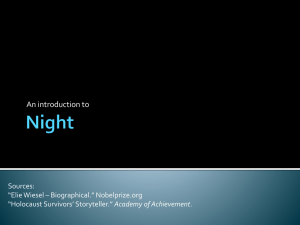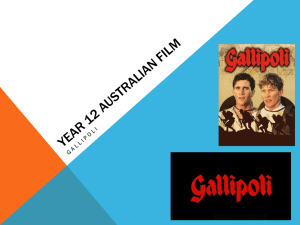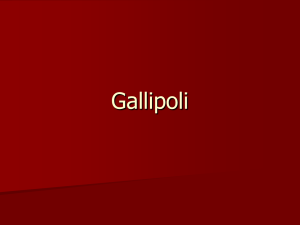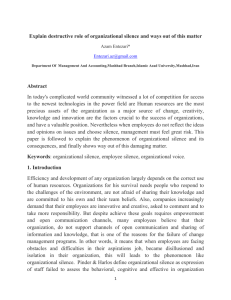ASO READER*S NOTES - Scholastic Australia
advertisement
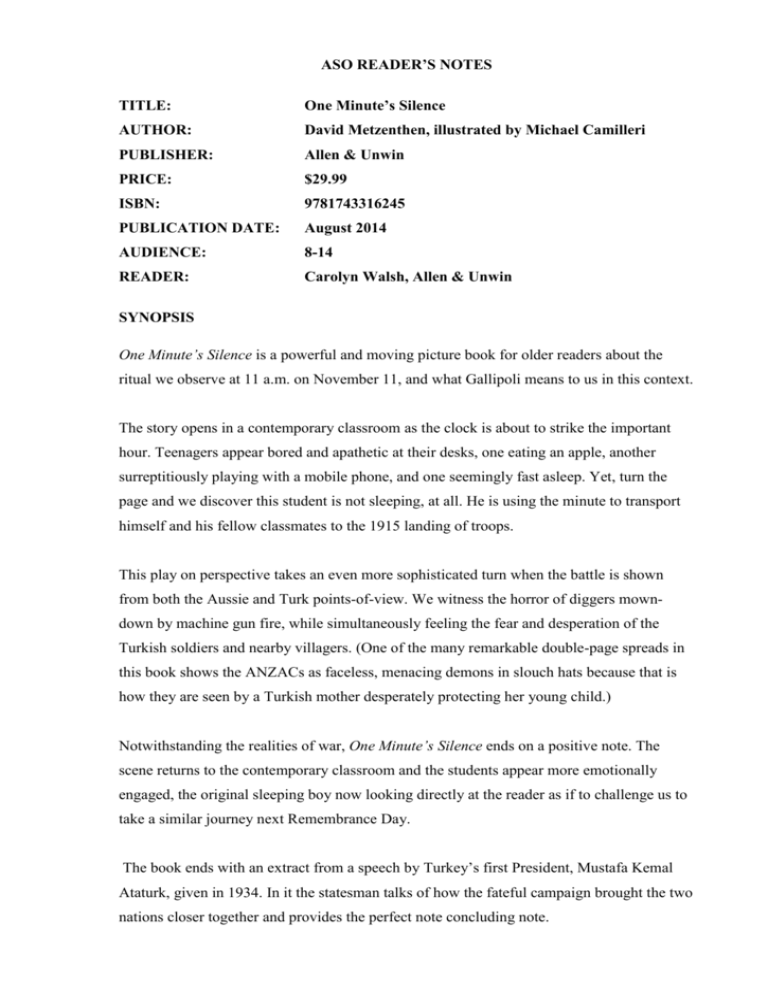
ASO READER’S NOTES TITLE: One Minute’s Silence AUTHOR: David Metzenthen, illustrated by Michael Camilleri PUBLISHER: Allen & Unwin PRICE: $29.99 ISBN: 9781743316245 PUBLICATION DATE: August 2014 AUDIENCE: 8-14 READER: Carolyn Walsh, Allen & Unwin SYNOPSIS One Minute’s Silence is a powerful and moving picture book for older readers about the ritual we observe at 11 a.m. on November 11, and what Gallipoli means to us in this context. The story opens in a contemporary classroom as the clock is about to strike the important hour. Teenagers appear bored and apathetic at their desks, one eating an apple, another surreptitiously playing with a mobile phone, and one seemingly fast asleep. Yet, turn the page and we discover this student is not sleeping, at all. He is using the minute to transport himself and his fellow classmates to the 1915 landing of troops. This play on perspective takes an even more sophisticated turn when the battle is shown from both the Aussie and Turk points-of-view. We witness the horror of diggers mowndown by machine gun fire, while simultaneously feeling the fear and desperation of the Turkish soldiers and nearby villagers. (One of the many remarkable double-page spreads in this book shows the ANZACs as faceless, menacing demons in slouch hats because that is how they are seen by a Turkish mother desperately protecting her young child.) Notwithstanding the realities of war, One Minute’s Silence ends on a positive note. The scene returns to the contemporary classroom and the students appear more emotionally engaged, the original sleeping boy now looking directly at the reader as if to challenge us to take a similar journey next Remembrance Day. The book ends with an extract from a speech by Turkey’s first President, Mustafa Kemal Ataturk, given in 1934. In it the statesman talks of how the fateful campaign brought the two nations closer together and provides the perfect note concluding note. AUTHOR STYLE In an intriguing and sometimes shocking interplay between words and illustrations, One Minute's Silence turns the perhaps overly-familiar version of the Gallipoli story on its head Images of the bored teenagers prepare us for the ‘usual’ Gallipoli story, replete with gung-ho clichés about ‘wild colonial boys’ dashing ‘across the shivering Turkish sand’. The text reminds us that ‘you can imagine’ such a thing: in other words, we have heard it all before. The twist, however, is on the next spread: ‘But can you imagine...’. What follows is the other side of the battle, with equally heroic language, but less time-worn phrases, and the faces of the now-engaged school kids inserted into the lines of Australian and Turkish troops. These alternating scenarios continue with graphic sepia-toned illustrations reminding the reader of the horror of war - the damage done by bullets and bombs, the constant presence of flies and countless corpses. Sparse but evocative language complements each illustration, underscoring the tragedy experienced by both sides. HOW THE IDEA FOR THE BOOK FORMED - IN THE AUTHOR’S OWN WORDS ‘The idea for this book came about when I was thinking about the hour we lose when daylight saving begins. I wrote a picture book about times past and people gone [which eventually became] a story about the one minute of silence we observe for our fallen soldiers.... [a] magical minute of reflection. ‘I was walking my dog thinking about this, and came up with the concept of what we can imagine in one minute’s silence... and what we might find more difficult to imagine – although it really did happen. ‘And so the story of the Aussies and Turks who fought at Gallipoli is presented, asking the reader to imagine the battle from both sides as they went about the business of trying to kill each other.’ WHAT DAVID METZENTHEN HOPES TO ACHIEVE WITH THE BOOK ‘The essence of this story is to present two sides of a conflict that traditionally we only ever see from our perspective. We can imagine ourselves to an extent, yes, but if we try, we might be able to imagine our enemy, and see that he is not so different from us. ‘I would also like people to know that although we were an invading force at Gallipoli, the leader of the Turks welcomed our dead as sons of his country. It was a beautiful gesture and its significance should never be forgotten or over-looked. ‘And I [wanted] to celebrate courage, loyalty, and the concepts of mateship being universal.’ AUTHOR BACKGROUND INFORMATION David Metzenthen is the much acclaimed, awarded, loved and respected author of over 30 books, and his most recent book for teenagers, Jarvis 24, was the winner of the CBCA Book of the Year for Older Readers in 2010. He has a knack for getting inside the head of his young male protagonists, and for addressing topics that are quintessentially Australian. ILLUSTRATOR BACKGROUND INFORMATION Michael Camilleri is a Melbourne artist who creates books, comics and visual theatre. His illustration work features in The Devil You Know by Leonie Norrington and on the album art and accompanying picture book for Martin Martini's Vienna 1913. He lives with his partner Katherine and their son Ruben. You can visit him at www.epicboy.com EDUCATIONAL APPLICABILITY Themes include: Gallipoli, the universal tragedy of war, Remembrance Day One Minute’s Silence sits comfortably within the Australian Curriculum’s General Capability: Intercultural Understanding through historical fiction. Suggestions for discussion and classroom activities: Preparatory Research Exercise: Encourage students to find out as much as possible about the following areas BEFORE reading the book: Reasons for Australia and Turkey’s involvement in WW1 Location of Gallipoli and its strategic importance Timeline of major events between troops landing and withdrawing Why we stop for a minute of silence at the eleventh hour of the eleventh day of the eleventh month Encourage students to look into their own family history and find out if they had a relative who fought in WW1 (on any side). Before reading One Minute’s Silence ask students to consider the title and cover design. What sort of story do students expect this to be? Will it be predominantly fiction or non-fiction? Who might it be about? What things on the cover give clues to the answers of these questions? If students are struggling with this task prompt them by asking these questions: - Why might the illustrator have chosen to show two faces on the cover that are very similar but, on closer inspection, have some subtle differences? - What significance does the use of sepia tones have? - Why is the only colour used on the cover the red/orange of the title? - What does a circle and small crosses make you think? Read the book once and in a general class discussion invite students to discuss their initial reaction to the story and how the book’s primary message might be reduced to one sentence. Compare and contrast the two double-page illustrations of the contemporary students sitting in their classroom. What might be the significance of the later image? Language exercise: Why has the author repeated the lines, ‘...you can imagine’ and ‘can you imagine....’ throughout One Minute’s Silence? Hint: the first always relates to the well-established story of Gallipoli and the second relates to the lesser-known experience of the Turkish troops and civilians. Visual exercise: Examine the image of the boy’s face in close-up on the second double-page spread. In what ways do perspective, orientation, contrast (with the image in the previous spread), tonal changes and concentration of pencil stroke create a sense of entering the boy’s internal world of imagination. Ask students to form into groups of two or three to discuss the significance of the close-up images of the clock, fly, bullet and gun? Essay Questions: In what way has your reading of One Minute’s Silence enriched your understanding of Remembrance Day? or How does President Ataturk’s 1934 speech, from which an extract appears on the final page of the book, reflect the messages contained in One Minute’s Silence? MARKETING AND SELLING POINTS David Metzenthen won the CBCA Book of the Year for Older Readers in 2010. One Minute’s Silence will feature prominently in the Allen & Unwin Primary and Secondary School newsletters. Review copies of One Minute’s Silence will be mailed broadly to relevant media. A specially produced poster will be sent to 2000 primary and secondary schools in Australia and New Zealand during July 2014. The book will be advertised in the October edition of Literature Base.

